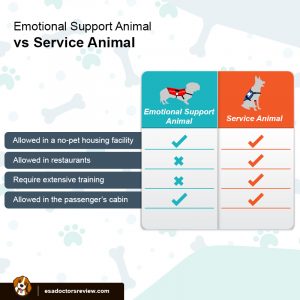Caring about animal welfare is the compassionate thing to do. That’s because animal ownership brings forth new responsibilities. At the same time, it’s essential that you understand how those responsibilities are defined in the law.
Click on the button below and read about the best ESA clinic reviews.
Pets are our greatest companions in the animal kingdom. As such, there are numerous physical and emotional benefits associated with animals. However, many pet owners try to skirt laws by falsely claiming their animal is an ESA or a service animal in an effort to save money. This is the reason why many people have asked to revise the ADA to avoid any confusion.
So, why is there so much confusion between service animals and Emotional Support Animals?
Hidden field
Emotional support animals (ESA) and service animals serve a higher purpose other than being a regular house pet. While both serve humans, ESAs and service dogs are often confused.
The two terms differ with respect to the roles the animals play and your legal rights as the owner. Yes, there are different laws covering the rights of Emotional Support Dogs and Service Dogs. While Emotional Support Animals and Service Animals are covered by federal statute, they are specifically and individually covered by different laws.
You should check your state’s law and follow the law that offers the most protection for service animals. While the laws governing ESAs and Service Animals are different, they are both key assets for many people.
This article provides guidance on the laws that govern service animals and ESAs. Read on to learn which animals qualify as Service Animals or as ESAs.
But before that why not read honest reviews about some of the best ESA clinics? Just click on the banner below.

1. ESA VS. Service Animals
It is important to take into account the differences between ESAs and Service Animals. A number of animals can qualify as an ESA. However, a shortlist of animals can become Service Animals under federal law. Here is a brief introduction of Service Animals and Emotional Support Animals.
Emotional Support Animals (ESA)
There are many benefits to having a dog, from getting yourself out for exercise to receiving loyal companionship. However, animals can also provide emotional support for people with mental health concerns.
Emotional Support Animals are one way to provide ongoing support to individuals with a serious depressive disorder. They bring comfort and minimize the negative symptoms of the person’s emotional or psychological disability.
Unlike service dogs, these animals require no special training. Furthermore, the assistance animal is not a pet, according to the U.S. Department of Housing and Urban Development (HUD).

Similarly, in order for your animal to be accepted as an ESA, you must have an Emotional Support Animal Letter from a licensed health official. As a result, ESAs are protected under federal laws in housing situations with no-pet policies.
However, some state governments have regulations that allow people to take Emotional Support Animals to many places.
The Air Carrier Access Act (ACAA) allows for Emotional Support Animals for any person that has a disability. These animals are always allowed to accompany their owners in any public or private transportation vehicle or facility.
Common ESAs
Any domesticated animal can potentially qualify as an Emotional Support Animal. However, ESAs are typically dogs and cats. Some of the other common Emotional Support Animals include:
- Horses
- Rabbits
- Guinea Pigs
- Reptiles
- Birds
Any animal you choose must be under your control. This means no barking, running around, or jumping in public.
Wanna get an ESA? Don’t forget to read reviews about authentic ESA letter providers.

Service Animals
A service animal is any animal that is trained to perform tasks for the benefit of a person with a disability. They can also calm someone with post-traumatic stress disorder (PTSD) during an anxiety attack.
This training could be done by an organization, but it does not have to be under the ADA.
Service animals are sometimes called helper animals or support animals. They are also usually paired with one particular person, often for life.
A support animal can be any reasonable animal, although most airlines don’t accept anything but a dog, mini horse, or cat. Most often, it’s dogs that are used as service animals due to their relatively high intelligence. Common service dog breeds can range from very small to very large.
Federal regulations allow for a comprehensive definition of service animals under the Americans with Disabilities Act (ADA). In September 2010, a final rule was published to amend the service animal definition to be limited to dogs.
Consequently, cats, monkeys, snakes, rabbits, or other types of animals are not considered service animals under DOJ’s rules. Furthermore, dogs whose only role is to offer emotional support or comfort do not qualify as service animals.
It is also important for staff members at establishments such as restaurants to know how they can properly verify a service dog. The staff members need to look at the specific service animal to determine if it poses a threat to the health or safety of other people.
Examples of such establishments are hotels, restaurants, bars, movie theaters, and sports stadiums.
Click on the button below and read reviews about ESA clinics.
2. Specific Services Offered by Emotional Support Animals and Service Animals
Service dogs and ESAs all fulfill essential roles in their aid to humans. Both ESAs and service animals fall under the same category when it comes to their rights, but there are a few differences.
For instance, relevant laws, health factors, appropriate facilities, and cultural expectations will vary. Nevertheless, the task of a service or ESA animal must be directly related to the individual’s disability.
Emotional Support Animals
An Emotional Support Animal does nothing but offer comfort to their owner; therefore, they are of very little use to people who have some sort of physical disability. ESAs aid the psychologically disabled to cope better with their disability. Some of these disabilities include:
-
Anxiety Attack
Anxiety disorders are the most common mental illness in the United States. An anxiety attack is a feeling of overwhelming apprehension, worry, distress, or fear. It causes increased alertness, fear, and physical signs, such as a rapid heart rate. Anxiety disorders can also make it hard to breathe, sleep, and stay still.

Experiencing occasional anxiety is a normal part of life. However, for a person with an anxiety disorder, the anxiety does not go away. It’s no wonder then that many people are moving toward more holistic approaches to treatment, such as getting Emotional Support Animals.
Emotional Support Animals (ESAs) are perfect for people in distress. ESAs for anxiety improve the lives of those who experience feelings of fear and worry. For those dealing with depression, they can be especially important for improving the quality of life and health.
Other benefits of being with ESAs include:
- less fear
- better mood
- better social interactions
The main focus is to provide complete comfort to the patient.
All we want is to lead you to the best ESA clinic. Be smart, look deeper and read reviews.

-
Mental Disabilities
Animals can play a very important role in assisting people with mental disabilities. ESAs help individuals with mental disabilities by providing comfort and support. Research has shown that having an Emotional Support Animal increases levels of oxytocin and reduces levels of mental illness.
Therefore, if you are suffering from mental illnesses, the comforting presence of an ESA can truly make your road to recovery easier.
-
PTSD
PTSD is a mental health problem that’s caused by a terrifying occurrence— either being affected by it or witnessing it. Someone with PTSD often relives the traumatic event through nightmares and flashbacks and may cause clinically significant distress or impairment in the person’s social interactions.
The condition was first recognized in war veterans and has been known by a variety of names.
Counseling, cognitive behavior therapy (CBT), or medication helps to treat PTSD. However, if you are suffering from PTSD, you may find that an ESA is a good addition to your therapy program.
The love and support of an ESA is especially important because your friends and family members may have trouble understanding your condition.
According to the ADA, ESAs can calm a person with post-traumatic stress disorder (PTSD) during an anxiety attack. These companion pets can also alleviate the symptoms of an individual’s disability.
Click below to read reviews about authentic ESA Letter providers!
-
Depression
Depression is an emotional state punctuated by feelings of guilty and self-loathing. It is often marked by a loss of interest or constant sadness.
This can cause severe symptoms that affect how you feel, think, and handle daily activities. Some people experience these feelings for long periods and sometimes without any obvious reason.
In the US, depression affects roughly 6.7% of the population over 18 years of age. With proper diagnosis and treatment, the vast majority of people with depression will overcome it. However, some people can recover from depression by getting an Emotional Support Animal.
ESAs may offer a more affordable way of improving symptoms of depression. This is due to the fact that animals have an amazing ability to lift your spirit just by being there.
This can also dramatically improve your overall mental health and decrease the debilitating effect of depression.
-
Obsessive-Compulsive Disorder
OCD is a common, chronic, and long-lasting disorder in which you have unwanted thoughts or sensations that make you feel driven to do something repetitively. Obsessive-Compulsive Disorder can affect men, women, and children. However, it usually begins in late childhood or early adolescence.
Believe it or not, there is an emotional support dog for individuals suffering from OCD. Evidence suggests that the presence of ESAs can reduce the subjective experience of Obsessive-Compulsive Disorder. Something as simple as being greeted by a happy dog with a wagging tail can help alleviate OCD symptoms. Similarly, dogs can increase your neurochemicals like dopamine through bonding and love.
Read some reviews of your favorite ESA clinic on the link below.

Service Animals
Right now, only dogs and very occasionally miniature horses can be considered service animals. These animals serve many purposes, including:
1. Physical Disabilities
-
Mobility Impairments
Service animals can carry and pick up objects for individuals with mobility impairments. They can also help a person with poor balance and assist those who use wheelchairs. However, these service animals must be in your control at all times by leash and/or harness.

-
Diabetes
Service dogs are able to help those with diabetes, thanks to their heightened sense of smell. These service animals can detect hypoglycemia and inform you or others to treat it. In particular, they can tell you if your blood sugar is dropping, and they can also retrieve diabetes test kits or medications.
This allows you to take the proper steps to return your blood sugar to a normal healthy range.
-
Allergies
Anyone with respiratory anaphylaxis can benefit from having a service dog. Generally, service dogs are used when an allergy severely impacts your well being.
These dogs can aid you by checking areas for traces of nuts, in particular, peanuts, walnuts, and cashew nuts. The dog can also indicate the presence of the allergen upon entering a new environment.
-
Cardiac and Respiratory Disabilities
Service animals are trained specifically to detect shifts in heart rhythm and blood flow. They can also detect lower or higher sugar, serotonin levels, and other hormonal changes too. They can then issue a quick alert signal when you are experiencing or about to experience a hyperglycemic or hypoglycemic episode.
This advance warning allows the individual to take essential medication, lie down, or rest. Moreover, service dogs can be an enormous consolation and source of stress reduction during heart attacks.
It will take only a few minutes, go ahead, and read reviews for different ESA services providers.
2. Sensory and Neurological Disabilities
-
Autism
Service dogs can provide emotional support and physical safety for children with autism. They help them improve social interactions and relationships, and improve nonverbal and verbal communication skills. By increasing this type of interaction, the child with autism receives more verbal stimulation.
They can also provide deep pressure therapy and act as a deterrent for self-harm.
-
Epilepsy
Service dogs provide protection and relief to those who suffer from seizure disorders. These animals can perform a wide range of epileptic tasks, including barking to alert caregivers when a seizure occurs.
They can also alert others, protect the person, and help them as they recover from the seizure. Moreover, they can detect oncoming seizures and provide assistance during an attack.
-
Visual Disability
Many blind people can’t get around without the help of a well-trained service animal. Generally, there are over a dozen different specializations for service dogs.
These dogs are trained to guide you around obstacles, such as other people, potholes, and telephone poles. They can also enhance your independence by helping with tasks such as pulling a wheelchair and turning light switches. As a bonus, service dogs may also lead to positive interaction with other people.
-
Hearing Disability
A service animal that aids deaf people is also known as a ‘hearing dog.’ Service dogs are usually trained to help people who are deaf or have a hearing loss. The most important thing a hearing dog offers its handler is an increased awareness of his or her environment.
That’s because they are naturally attentive to noises in their environment and can react calmly to unfamiliar sounds.
Service dogs can alert their deaf handlers by making physical contact and then directing them to the sound’s location. For these dogs to work effectively, they must have access to many places. That’s why service animals must be given access to almost everywhere their human handlers go.
Make sure you read reviews before you make a choice.

3. The Training Process of Service Animals and ESAs
Training a dog to become a service animal doesn’t happen overnight. Read on to know the differences between the training process of an emotional support animal and a service animal.
Emotional Support Animals
Emotional Support Animals do not require any specialized training. They do not have any particular schools or institutions where they get training for being an ESA. Although Emotional Support Animals do not have to be as highly trained as service animals, poorly trained ESAs are a threat to the health, safety, and function of people and themselves.
Normally, tailoring training programs for all kinds of animals exist to meet each person’s individual needs. Either way, the main training requirement seems to be that the animal is domesticated and provides a service to its handler.

Though the exact requirements of each test vary, most of them require that the animal is screened for its ability to interact favorably with humans and other animals. An ESA is trained to be friendly, patient, confident, gentle, and at ease in all situations.
Handlers of ESAs must also have the skills and confidence required to include their animals in their daily practice and in a manner that is safe.
Service Animals
Before taking your service dog for training, you must show a disability diagnosis certificate from a licensed physician stating that a service animal will assist you with your disability. The international standard is 120 hours for a minimum of six months or more.
There isn’t a set requirement for hours in the U.S., but a period of over six months is preferred. Moreover, the costs can vary widely for owner service dog training.
These highly trained dogs do a wide range of assignments that allow their handlers to have greater hope, independence, and freedom. Depending on your preferences, your service animal can undergo training for mobility assistance and medical assistance.
It will take only a few minutes, go ahead, and read reviews for different ESA services providers.
Should you choose to enroll your pet, a trainer will evaluate it. This is meant to gauge whether the animal can master the complex behaviors required for public access and advanced training.
The animals can be taught to open doors, pick items up off the floor, and retrieve a phone if you fall. The dog can also be trained to detect an anxiety attack long before it happens and alert you to take medications.
Highly trained service animals work for their owners with a number of services, such as:
- Sniff out illegal drugs, explosives, blood, human remains, and more.
- Alert their handlers to important sounds, including doorbells and knocks on the door.
- Possess a stable, even temperament without anxiety and reactivity.
- Bring medication or water to help swallow medication.
- calm an individual who suffers from PTSD, and even dial 911 in the event of an emergency.
- Open/close doors, drawers, and refrigerators.
- Pick up dropped items.
- Provide a focal point when situations become difficult to cope with.
- Turning Lights On.
- Turning Lights Off.
- Deposit Garbage Into Can.
- Carry Mail From Mailbox to House.
- Smell the chemical body changes that occur as insulin levels increase or drop.
- Alert the person or the caregivers to take action when a panic attack occurs.
Some breeds are particularly effective because they tend to remain in constant physical contact. However, there are a number of issues that you should be aware of. For instance, a diabetic alert service dog is never 100% accurate.
Click on the button below and read reviews about an ESA clinic.

4. Adoption Process of Service Animals and Emotional Support Animals
The process of adopting a service animal or an ESA is time-consuming, but it’s a worthwhile task. Therefore, make sure to allow for plenty of time to get the adoption process completed.
Click on the button below and find out which clinic is offering the best consultations.
The qualifications for adoption don’t all center around floor-to-ceiling checklists. Instead, each adoption agency has its own requirements. Additionally, each state has its own unique service animal and ESA adoption laws.
Here’s how the process works.
Emotional Support Animals (ESAs)
It’s important to know what to look for when adopting an emotional support animal. Therefore, start by conducting research as certain breeds are better suited for emotional support than others. Generally, there are many different types of therapy animals to choose from.
If you are mostly immobile, a cat may be the best choice since you won’t have to walk it.
Most people choose to adopt a dog. However, with so many choices on offer, deciding on a breed isn’t always easy. When choosing a dog, consider what type suits you best. Some of the most adorable ESA dogs are purebreds, while others are mixed-breeds.
At the same time, you have to visualize what your life would look like with your dog. Will, your dog be left home alone for long periods? Remember that if you just choose a dog that you find cute, you may end up with an unsuitable dog.
The next step is to find an eligible animal service provider. Choosing a service animal provider can be one of the most critical decisions that you make in your ESA’s life.

When choosing an animal service provider, you must focus on getting someone that you and your animal are comfortable with. Next, you will need to complete and submit an application with all the required supporting documents attached.
It will take only a few minutes, go ahead and read reviews for different ESA services providers.
Service Animals
Finding out if you qualify or don’t qualify for a service dog can be a difficult task. That’s because there are lots of meanings of the term disability and service animals. For instance, not every physical disability automatically qualifies an individual for a service animal.
Either way, you must have a diagnosed physical or mental disability, or a neurological disorder affecting at least one limb. In addition, the service dog must be able to carry out a critical task that you have great difficulty performing.
This means the work is done or tasks performed must be directly related to your disability. Furthermore, the service dog must have high trainability and be alert to stimuli (such as behavioral signs of human anxiety). Because of this very important purpose, service dogs and their owners have certain rights in public spaces.
Next, you’ll need to determine the breed of the dog that is ideal for you. A few breeds likely come to mind when you think about service dogs, like the greyhound.
However, there are specific breeds of dogs out there who are especially suited for serving as service animals. Similarly, some dog breeds have a strong drive to help out and be put to work.
Labradors make great service animals and can perform a variety of services. That’s because they are sociable and hardworking critters with a lot of love to give. Similarly, the poodle is a perfect service dog because it can assist with food allergies or home care.
Other people choose to go with Boxers because they are happy, clownish, and one of the best dog breeds for service dogs.
Another common breed is St. Bernard. This is, by far, one of the most popular service dog breeds in history. It is known for having stable temperaments, is task-oriented, and is physically powerful.
After selecting your preferred dog breed, you’ll need to get a service dog trainer from a reputable organization. The ideal service animal provider must have experience in training dogs, ranging from all levels of behavioral modification to obedience training.
Read some reviews of your favorite ESA clinic on the link below.

5. Legal Status of ESAs and Service Animals
Emotional Support Animals
What are the laws protecting Emotional Support Animals and service animals? Emotional Support Animals and service animals have different rights and responsibilities under federal and state laws. Some of these laws are:
-
The Air Carrier Access Act
This law guarantees that persons with disabilities get consistent and non-discriminatory services during air travel. It also stipulates the obligations of airlines to accommodate passengers requiring special needs. Moreover, this regulation allows for alternative versions of access to be used and supplemented.
The Act applies to service animals because it prohibits discrimination in air transportation. ESAs can travel with the owner in the open without the restriction of being caged. In the terminal, airlines must provide animal relief areas.
However, you may be required to have certain documentation if you intend to travel with an emotional support or service animal. This only applies to persons with disabilities and not to all persons with mental illness.

-
The Fair Housing Act
The Fair Housing Act (FHA) is a federal regulation that illegalizes discrimination against tenants with disabilities. That includes people with restrictions, special needs, or assistive aids, such as Emotional Support Animals.
The law regards an ESA as a “tool” for aiding an individual with a disability. Similarly, weight and breed limits do not apply to assistance or service animals. These laws must be obeyed by:
- Building lot owners
- Real estate agents
- Leasing agents
- Rental managers
- Financial institutions
Under the Act, a landlord can’t decline to accommodate a disabled person just because their insurance doesn’t cover Emotional Support Animals. This means that you can’t be denied housing based on an animal that you require as support.
Similarly, the property owner cannot demand any documentation for the ESA or require that it demonstrate its ability to perform a task. Furthermore, they may not demand access to medical records or unreasonably delay your rental request. The 2020 regulations also stipulate that housing providers can’t impose charge deposits and fees or impose breed/weight restrictions for ESAs.
However, the landlord can ask a few questions to determine whether an animal qualifies as an ESA. Also, you should be aware that there is a presumption that one animal is enough. At the same time, your tenancy can be declined if your animal poses a direct threat to the safety or health of other tenants.
Be smart, look deeper, and don’t forget to read reviews before you go!
Service Animals
-
The Americans with Disabilities Act (ADA)
The Americans with Disabilities Act (ADA) was created to protect the civil rights of those with disabilities. It went into effect in 1990. ADA’s primary purpose is to ensure that people with disabilities have the same human, legal, and civil rights as others. In the context of the ADA, “disability” is a legal term rather than a medical one.
When the law was initially enacted, the protections offered for individuals utilizing animals for medical and emotional support were limited. The law now specifies the definition of a service animal and the rights of individuals with disabilities.

In addition, the law applies to all public facilities, such as restaurants, hotels, taxis and shuttles, grocery and department stores, and many others. For example, in a hospital, it would be illegal to prevent a service animal from accessing spaces such as patient rooms. This means that these places must allow service dogs.
Besides, the ADA requires public facilities to provide adequate information on services in accessible formats for individuals with disabilities.
The ADA requires public accommodations to allow service animals to accompany their owners. Besides, public accommodations can’t require special ID cards for the animal or ask about the person’s disability. At the same time, the ADA regulations do not restrict the type of dog breeds that can be service animals. However, service dogs must be under control at all times.
According to ADA, service animals perform some of the tasks that you can’t perform. This means that the animal must actually perform an action or task that benefits you. Other support or therapy animals are not covered under the ADA.
Don’t forget to read reviews about authentic ESA letter providers.

6. The Qualifications of ESA and Service Animal Handlers
Do you qualify for a service dog or an emotional support animal (ESA)? Here are the requirements that you must satisfy before you are allowed to own an ESA or a service animal.
-
Emotional Support Animals
Anybody from anywhere in the United States can own an emotional service animal, regardless of race, religion, or gender. If you have an emotional disability, you can legally qualify for an ESA. Your disability could be sensory, psychiatric, intellectual, or mental.
You may need a doctor to sign a verification form to complete that process. This is basically a signed letter stating that you have an emotional health challenge and that your pet helps you deal with it. The letter is the main and most important piece in the process of actually getting an emotional support animal. This is required so that people won’t abuse this system.

Some of the eligible emotional disabilities include bipolar disorder, depression, fears and phobias, postpartum depression, and social anxiety disorder.
The ADA regulations do not require you to register your emotional support dog.
-
Service Dog
While anyone can own a trained service dog, not anyone can use it. First, a treating physician must diagnose you with a qualifying disability.
In most cases, all that is needed to qualify is a letter from your medical professional. The physician’s letter must indicate what specific assignments the service animal is required to master to provide the needed assistance.
In addition, there will be interviews and application forms intended to determine exactly how a dog can be most helpful. You may find it beneficial to seek further information from your doctor, employer, and landlord.
Click on the button below and find out which clinic is offering the best consultations.
Common Qualifying Disabilities
- Anxiety attacks
- Asthma
- Autism
- Blindness
- Cancer
- Diabetes
- Epilepsy
- Multiple sclerosis
- Paralysis
- Problems with speech
- Social anxiety
If you suffer from epilepsy, you may qualify for a seizure service dog. For a seizure condition to qualify, you must suffer at least one seizure every month. If your application falls within the legal criteria, you will be invited to find and adopt a trained service animal.
Final Thoughts
Remember that ESAs cannot be classified as Service Animals. That’s because service dogs receive more legal protections than emotional support dogs.
Emotional Support Animals are becoming a popular way to manage mental disabilities. As a person living with disabilities, you must know the potential benefits and risks of ESAs. Fortunately, a licensed healthcare professional can help you determine whether an emotional support animal is ideal for you.
Don’t forget to read reviews about authentic ESA letter providers.
Service animals are amazing dogs trained to compensate for many different types of disabilities. They are also trained for the honorable people who have disabilities and retired from the military. Service dogs can’t be denied access to any public space unless they are misbehaving in public. This means that your service animals must be under your control and housebroken.
Be smart, look deeper, and don’t forget to read reviews before you go!








